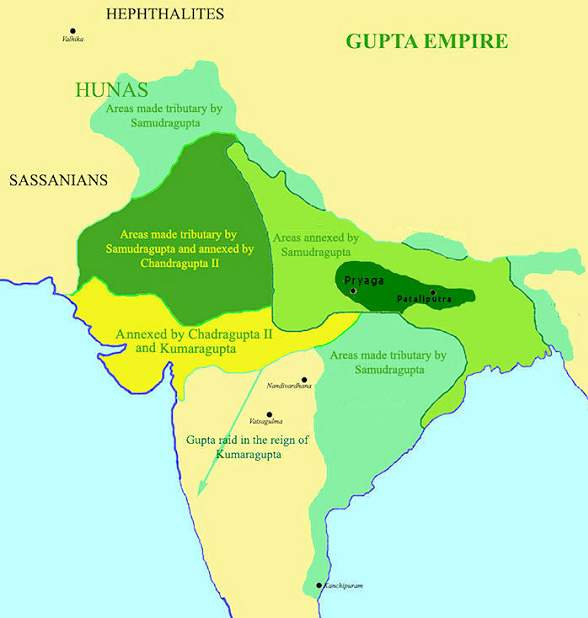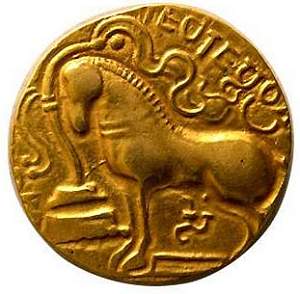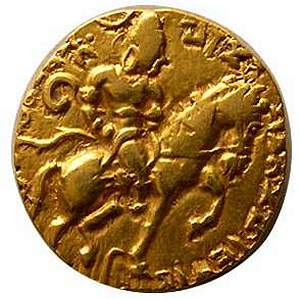Volume One
Ancient and Medieval States
Background
Medieval India

The Guptas
The 500 year period between the collapse of the Mauryan empire in 185 BC and the rise of the splendid Gupta empire, saw many small kingdoms war with each other in northern India. But when Chandragupta I ascended to the throne in AD 320, he revived many principles of Mauryan government and paved the way for his son, Samudragupta, to create an extensive empire. The Gupta empire was not marked by enormous material wealth or extensive trade, but by its creativity. The visual arts, architecture, literature and scholarship flourished under Samudragupta's successors. Chandragupta II gave great support to artists and craftsmen, actually paying for their work — unusual in ancient civilizations. Nalanda University was founded, Kalidasa wrote his great poetry, and the scientist Aryabhatta surmised that the earth was a rotating sphere, calculating the solar year to with 3 hours of its correct value. Narrative histories, religious and meditative thought, and lyric poetry emerged to enrich, educate, and entertain the people. Scholars wrote essays on subjects ranging from grammar and medicine to mathematics and astronomy. The Ajanta Caves in southern India are world famous, and are matched by magnificent architecture and sculpture elsewhere. The Gupta rulers practised Hindu rituals and religions — they were Vaishnavas — but there was widespread religious freedom: statues to Buddha and Shiva also appear. The empire weakened under White Hun invasions, and disappeared altogether around AD 550. {1-5}
The Gupta era produced the decimal system of notation and made advances in metallurgy. Their gold coins, the first characteristically Indian on the sub-continent, are particularly attractive. They were called the dinara after the Roman denarius aureus — a reflection of Indian trading contacts with the west and the export of Roman coinage as bullion to India. The Guptas probably obtained the gold and minting skills from Kushan, Roman or Byzantine sources, though their style is very different. {1-5} The artistic excellence lies in the images of rulers and deities depicted, their vitality and fluid exuberance rather than their Brahmi script, which is often blurred and/or off the flan. {6}
Changragupta II
Under Chandragupta II (c.380-c.415) and his immediate successors, the Gupta empire reached its height of prosperity. The Chinese traveller Faxian (337– c.422 AD) noted the absence of capital punishment, of land or poll tax, and that citizens seemed to emulate each other in the practice of virtue. Rest houses were provided for travellers, and the capital (Ujjain) had an excellent hospital.{7}
By marriage and conquest, Chandragupta II expanded his empire to Kashmir in the west and Orissa in the east. The Western Kshatrapas were taken into the empire, and the marriage of his daughter brought Vakataka realms into Gupta control. {7}
The Guptas issued a lavish gold coinage, and Chandragupta II both continued his father's designs and added several new types, such as the Horseman type and the Lion-slayer. After conquest of the Western Kshatrapas (Gujarat), Chandragupta II also issued silver coins — small pieces for the convenience of peoples he had conquered, based on the previous design but replacing the reverse three-arch-hill by the Gupta garuda symbol. {7}
Economy
| Agriculture was the basis of the Gupta Empire, but that agriculture was supplemented; by crafts on a semi-industrial scale and trade with China and Byzantium, all activities being greatly aided by ready loans provided at reasonable rates by Buddhist monasteries. Merchants and other traders were organised into guilds, to which were assigned certain rates of tax. Textile weaving flourished, including silk, muslin, calico, linen, wool and cotton goods, some of which were exported. {5} | |
Gupta Empire. Chandragupta II (375-415 AD) Au heavy gold dinar. 8.25 g. Obverse: king in tribhangha position with the bow and arrow and wearing a cholaka (an ancient warrior's uniform modified from a Kushan version) and short, tucked dhoti. Sash whip is tied to waist. Chandra under left arm. Legend (off flan): Devasrimaharajadhirajasri Chandraguptah. | Many crafts were also note-worthy: ivory working, stone-cutting, the carving of jasper, agate, quartz, carnelian, lapis- lazuli and similar semi-precious stones. Craftsmen also fashioned articles in gold, silver, copper, iron, bronze and lead. While pearl fishing was popular, pottery was far more important. {5} |
 | Following the conquest of Gujarat, the Gupta rulers also minted silver coins, plus some uncommon lead and copper issues. Trade extended to China (silk), Ceylon (spices) east Africa (ivory), Byzantium (gold) precious and other European countries. The Gupta is often called 'the golden age', and like the Mauryan before it (and the Han dynasty of China), the country was at peace and open to the free flow of commodities, skills and ideas. {5} |
Reverse: Goddess Lakshmi seated on lotus, holding a lotus in one hand and a diadem in the other. Legend (in Brahmi): Shri Vikramah. (Reverse variety N) | Ajanta, Ellora and the Bagh cave paintings show the popularity of Buddhist philosophy, but each centre has its distinctive style. Elegance is characteristic of all, however, which is also evident in its coinage. {5} |
Art and Coinage
Chandragupta I minted gold coins showing a king and queen on the obverse, and a goddess atop a lion on the reverse. Samudragupta issued gold coins in six different types, and just possibly copper coins in two types. Chandragupta II struck eight types of gold coins (standard, archer, lion-slayer, counch, king and queen on couch, horseman, chattra and chakraviikrama) and then small silver coins based on those of the Western Kshatrapas that he had conquered. After that conquest he seems to have minted lead coins, and some nine types of copper coins. Kamaragupta I continued the Gujarat silver types, and expanded the gold types to fourteen (archer, lion-slayer, chhara, tiger-slayer, asvamedha, lyrist, king and queen, karttiker, swordsmen, elephant-rider, elephant-rider-come-lion slayer, rhinoceros-slayer and apratigha). There were eight or nine different copper coins, and lead pieces that were round, square or rectangular. Skandagupta's issues in lead, silver and gold are much more restricted in types, which may indicate troubled times. Coins of the later Gupta were poorer in types, in execution and in gold content (falling from 70% to 50%). {9}
The gold pieces of Samudragupta, Chandragupta II and Kumaragupta I have the greatest claim to be numismatic works of art. The royal male figures, like their counterpart on Indian temples of the period exude muscular strength and vitality. The female forms, queens or deities, have soft, graceful and slender appearances, and though the legend is often blurred or off the flan, the individual letters tend to be part of the design, i.e. be aptly placed. {9}
In short, the gold coinage promotes the divine nature of the Gupta rulers, reflecting the well-known literary idea of 'God dwelling on earth'. Though they allowed other religions to flourish, the Guptas were careful to reflect their Vaishnava faith on coin reverses. Neither the Buddha nor Mahavira appear, only divinities associated with the Vaishnava and Sakti sects. Particularly telling are the deities associated with the Ganga and Yamuna rivers, which ran through Gupta territories. As is common in India, many of the figures show syncretism, a blending of features taken from different religions or sects. Artistic quality always depended on the skills of local die-cutters, but quality falls off after Skandagupta, the figures becoming stiff and mechanical. Art reflected the material prosperity of the empire. {9}
Divine Kinship
Reverses of Gupta coins depict the preoccupations and duties of the Gupta kings: leading armies, attending the appropriate rites and ceremonies, honouring their ancestors and hunting. There is no depiction of the everyday activities of their subjects because such matters were irrelevant. Kings were not ordinary mortals, not the 'first among equals' but elevated, semi-divine beings. Nonetheless, the individual qualities of the kings could be alluded to: their musical accomplishments or skills in the hunt.
The silver and copper issues are much more utilitarian, and respect the traditions of the conquered peoples. Chandragupta's silver coins are modelled on the previous issues in Gujarat, and there are equivalent (but rare) silver issues for the eastern parts of the empire where a peacock has replaced garuda. As always, coinage serves several purposes, but here a cleavage is apparent. The gold issues celebrate the Gupta kings. Issues in other metals serve practical purposes and emphasize social continuity.{8-9}
 |  | |
Gupta Empire Au dinar (7.62 g; 20 mm). c. 335-380 AD. Ashvamedha type. Obverse Sacrificial horse standing and facing left before pedestal with filleted yupa post, from which flutters a banner. "si" on footstool below. Reverse: queen, not nimbate, standing left on lotus-form mat, holding chouri (fly whisk) and cloth, suchi (filleted spear) before her. Brahmi legend right: Asvamedhaparakrama.. {3} | Gupta Empire Au dinar (7.67 g; 18 mm). Chandragupta II 375-414 AD. Obverse: King riding horse facing right. Holds a bow above the horse's head and a whip by his side. Reverse: Goddess Lakshmi, nimbate, seated left on wicker stool, holding diadem and lotus. {4} | Gupta Empire Au dinar (7.80 g) Chandragupta II 375-414 AD. Lion-slayer/ retreating type. Obverse: King standing with head facing left and legs apart. Long sash to belt and holds arrow in left hand. Thrusts bow in right hand towards fleeing lion. Reverse: Goddess saeted on lion walking right. She holds a lotus flower in raised left hand and a riband in her right. Sinhavikramah at right, tamgha above left. {5} |
Post-Gupta India
Much of India went back to a patchwork of small states between the eighth and twelfth centuries: largely self-supporting villages that were centred on a local court and/or religious centre. {22} There were periodic attempts to found small empires — Pratiharas, the Palas and the Rashtrakutas in the north, and the Cholas in the south — but Sind fell to the Arabs in the eighth century, and within two centuries various Turkic tribes had conquered parts of north and western Asia, setting up sultanates with a strong Persian culture. In the late twelfth century appeared new Turkic invaders, who created the Delhi Sultanate in northern India and came close to conquering the whole country. The Sultanate fragmented in the fourteenth century, and several kingdoms took their place: the Bahmani and Vijaynagar kingdoms indeed became very powerful.
New crafts, trade routes and technologies were introduced by these invaders, as they were when the Mughals in turn conquered and largely united the country. The sultanates were Islamic trading states, who brought their coinage and banking methods with them, but the indigenous states were less monetised.
But commerce did not disappear. Accounts — of loans, mortgages, contracts and interest rates applying — were still kept, though payment was often in kind. The largest lenders were monasteries and temples, which were lavishly maintained by ‘perpetual endowments’. Coinage largely disappeared, but not the treasuries of gold and temple goods, which provided the backing for loans of animals, wheat, silk, butter and fruit. Nor were the terms generous. Brahmins commonly paid 2% per month, and Sudras 5% a month. Since sons and grandsons inherited debts, these were quite sufficient to ruin families and reduce land-owners to debt peonage. As in Europe and China, secular rulers needed few excuses to seize these treasuries when financing their incessant wars. {14}
References and Further Reading
Need the 13 references and 5 illustration sources? Please consider the inexpensive ebook.
